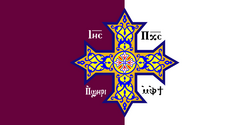User:Bigmoney/Sandbox: Difference between revisions
mNo edit summary |
mNo edit summary |
||
| Line 1: | Line 1: | ||
= | =Tyreseian Coptic Church= | ||
{{Infobox Christian denomination | {{Infobox Christian denomination | ||
| icon = Coptic_cross.svg | | icon = Coptic_cross.svg | ||
Revision as of 05:41, 24 September 2021
Tyreseian Coptic Church
The Most Holy Coptic Church of the Nazarenes | |
|---|---|
 | |
| Classification | Non-Nicaean |
| Orientation | Miaphysitism |
| Polity | Episcopal |
| Leaders | Presbyter Princeps Zephyrinus Victor I Rector Princeps Paul XXIII |
| Founder | Saint Paul (traditional) Saint Alban of Vigueria (traditional) Saint Euphrosynos of Adrianople |
| Origin | Apostolic Age Tyreseia |
| Members | 18 million (official records) |
The Tyreseian Coptic Church or Nazarene Copts, officially the Most Holy Coptic Church of the Nazarenes but more often simply referred to as Coptic Nazarism is a Sarpetic religion, operating as a distant offshoot of the Alban church. The faith is named after the now-abandoned !Greek-speaking settlement of Kóptos; this town is taught by Church tradition to be its birthplace following the arrival of Saint Euphrosynos of Adrianople. Working from a Gnostic interpretation of the Two Treasures, Euphrosynos preached a wholly dualistic vision of Yeshua and of the Godhead that quickly took root in the communities of modern-day Tyreseia and other fringes of the Alban world. Diverging from St. Alban's vision of a purely monastic polity, Euphrosynos created a largely episcopal structure that survives nearly unchanged to this day.
Still a largely Gnostic faith, the Coptic Church adopted elements of esoterism and mysticism over the centuries as part of a central belief that active pursuit of knowledge, especially through invention and exploration of the cosmos, brings the faithful closer to the Unbegotten and hastens the onset of the End Times.
At present, the vast majority of Copts live in Tyreseia, though smaller communities exist across the Periclean basin and elsewhere.